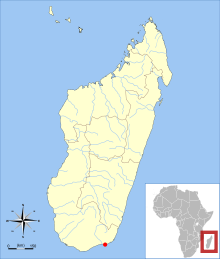Microgale macpheei
| Microgale macpheei Temporal range: Holocene
| |
|---|---|
| Scientific classification | |
| Domain: | Eukaryota |
| Kingdom: | Animalia |
| Phylum: | Chordata |
| Class: | Mammalia |
| Order: | Afrosoricida |
| Suborder: | Tenrecomorpha |
| Family: | Tenrecidae |
| Genus: | Microgale |
| Species: | †M. macpheei
|
| Binomial name | |
| †Microgale macpheei Goodman, Vasey, and Burney, 2007
| |

| |
| Location of Andrahomana Cave, the only place where Microgale macpheei has been found | |
Microgale macpheei is an extinct
Taxonomy
Remains of
Description
Microgale macpheei is known from two specimens: a damaged
The rostrum (front part of the skull) is short and blunt in both M. macpheei and M. brevicaudata, contrasting with the condition in other Microgale,
Distribution and ecology
Microgale macpheei is known only from the cave of Andrahomana.
Notes
- ^ The dental formula in Microgale is 3.1.3.33.1.3.3 (three incisors, one canine, three premolars, and three molars in both the upper and lower dentition). The three premolars are numbered 2, 3, and 4, as the first premolar is presumed to have been lost.[7]
- ^ This description is based on Goodman et al. (2007), published before M. grandidieri and M. brevicaudata were described as distinct species. Much of the material of "M. brevicaudata" used in the 2007 paper is in fact M. grandidieri.[9]
- ^ Goodman et al. (2007) are inconsistent in identifying the three molars as M1 through M3[4] or M2 through M4;[11] the former convention is used in MacPhee's 1987 revision of the genus.[12]
References
- ^ Goodman et al., 2007, p. 368
- ^ a b c d Goodman et al., 2007, p. 370
- ^ a b c d e f Goodman et al., 2007, p. 371
- ^ a b c d Goodman et al., 2007, p. 373
- ^ a b Olson et al., 2009, p. 1095
- ^ Muldoon et al., 2009, p. 1117
- ^ MacPhee, 1987, p. 11
- ^ a b Goodman et al., 2007, pp. 370–371
- ^ Olson et al., 2009, p. 1107
- ^ Goodman et al., 2007, table 1
- ^ Goodman et al., 2007, pp. 369–370
- ^ E.g., MacPhee, 1987, fig. 8
- ^ a b c Goodman et al., 2007, p. 374
Literature cited
- Goodman, S.M., Vasey, N. and Burney, D.A. 2007. "Description of a new species of subfossil shrew tenrec (Afrosoricida: Tenrecidae: Microgale) from cave deposits in southeastern Madagascar" (subscription required). Proceedings of the Biological Society of Washington 120:367–376.
- MacPhee, R.D.E. 1987. "The shrew tenrecs of Madagascar: systematic revision and Holocene distribution of Microgale (Tenrecidae, Insectivora)". American Museum Novitates 2889:1–45.
- Muldoon, K.M., de Blieux, D.D., Simons, E.L. and Chatrath, P.S. 2009. "The subfossil occurrence and paleoecological significance of small mammals at Ankilitelo Cave, southwestern Madagascar" (subscription required). Journal of Mammalogy 90(5):1111–1131.
- Olson, L.E., Rakotomalala, Z., Hildebrandt, K.B.P., Lanier, H.C., Raxworthy, C.J. and Goodman, S.M. 2009. "Phylogeography of Microgale brevicaudata (Tenrecidae) and description of a new species from western Madagascar" (subscription required). Journal of Mammalogy 90(5):1095–1110.
